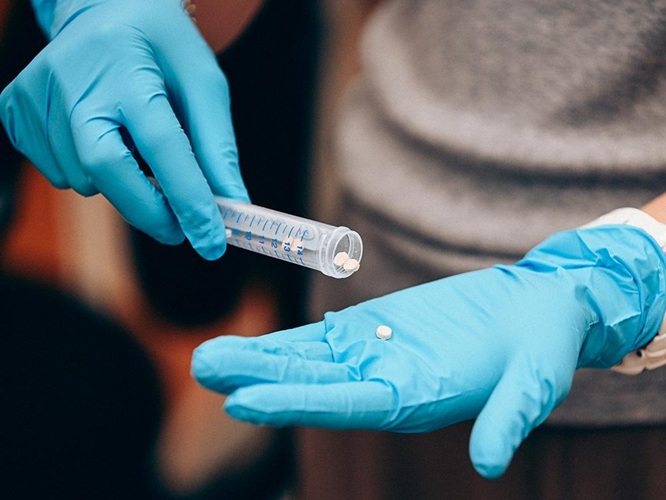Lower Ventilation Pressure Sufficient for Healthy Lungs
|
By HospiMedica International staff writers Posted on 22 Dec 2020 |
Low positive end-expiratory pressure (PEEP) protocols for ICU patients without acute respiratory distress syndrome (ARDS) are no worse than higher levels, according to a new study.
Researchers at Amsterdam University Medical Centers (AMC; The Netherlands), Hospital Israelita Albert Einstein (São Paulo, Brazil), and other institutions conducted a study involving 980 patients (median age 66, 36% women) in eight ICUs in the Netherlands to determine if a lower PEEP strategy (0-5 cm H2O) was non-inferior to a higher PEEP strategy (8 cm H2O). All patients were without ARDS, and were not expected to be extubated within 24 hours of ventilation initiation. The primary outcome was the number of ventilator-free days at day 28.
The results showed that at day 28, patients in the lower PEEP group had a median of 18 ventilator-free days, while those in the higher PEEP group had a median of 17 ventilator-free days. Mortality was 38.4% versus 42%, occurrence of severe hypoxemia was 20.6% versus 17.6%, and need for rescue strategy was 19.7% versus 14.6%, respectively. In addition, there were no major differences in duration of ventilation, ICU, or hospital lengths of stay, pulmonary complications, and the other secondary endpoints. The study was published on December 9, 2020, in JAMA.
“There has been a gradual and noticeable increase in use of higher PEEP in patients without ARDS in ICUs worldwide,” concluded senior author Marcus Schultz, MD, PhD, of AMC, and colleagues. “It may not be better to use a lower PEEP strategy, but it could be as good as higher PEEP. These findings support the use of lower PEEP in patients without ARDS.”
Ventilation with higher PEEP may lead to a better distribution of lung aeration, improving oxygenation, and could even prevent ARDS. However, it could also worsen existing or cause new lung injuries, since ventilation with higher PEEP impairs blood hemodynamics and increases the need for additional fluid administration or vasopressors. And because it is common practice to extubate at lower PEEP, use of higher PEEP could also delay weaning in some settings. The study was concluded before the onset of the COVID-19 pandemic.
Related Links:
Amsterdam University Medical Centers
Hospital Israelita Albert Einstein
Researchers at Amsterdam University Medical Centers (AMC; The Netherlands), Hospital Israelita Albert Einstein (São Paulo, Brazil), and other institutions conducted a study involving 980 patients (median age 66, 36% women) in eight ICUs in the Netherlands to determine if a lower PEEP strategy (0-5 cm H2O) was non-inferior to a higher PEEP strategy (8 cm H2O). All patients were without ARDS, and were not expected to be extubated within 24 hours of ventilation initiation. The primary outcome was the number of ventilator-free days at day 28.
The results showed that at day 28, patients in the lower PEEP group had a median of 18 ventilator-free days, while those in the higher PEEP group had a median of 17 ventilator-free days. Mortality was 38.4% versus 42%, occurrence of severe hypoxemia was 20.6% versus 17.6%, and need for rescue strategy was 19.7% versus 14.6%, respectively. In addition, there were no major differences in duration of ventilation, ICU, or hospital lengths of stay, pulmonary complications, and the other secondary endpoints. The study was published on December 9, 2020, in JAMA.
“There has been a gradual and noticeable increase in use of higher PEEP in patients without ARDS in ICUs worldwide,” concluded senior author Marcus Schultz, MD, PhD, of AMC, and colleagues. “It may not be better to use a lower PEEP strategy, but it could be as good as higher PEEP. These findings support the use of lower PEEP in patients without ARDS.”
Ventilation with higher PEEP may lead to a better distribution of lung aeration, improving oxygenation, and could even prevent ARDS. However, it could also worsen existing or cause new lung injuries, since ventilation with higher PEEP impairs blood hemodynamics and increases the need for additional fluid administration or vasopressors. And because it is common practice to extubate at lower PEEP, use of higher PEEP could also delay weaning in some settings. The study was concluded before the onset of the COVID-19 pandemic.
Related Links:
Amsterdam University Medical Centers
Hospital Israelita Albert Einstein
Latest Critical Care News
- New Autoinjector Could Transform Trauma Care in Severe Bleeding Emergencies
- Portable Light-Based Brain Monitor Improves Dementia Diagnosis
- New Ultrasound Technique Enables Safer Vein Access in Critically Ill Patient
- CVD Risk Prediction Tool Could Guide Statin Therapy
- Wearables Could Revolutionize Pregnancy Monitoring and Detect Abnormalities
- AI Model Identifies AF Patients Requiring Blood Thinners to Prevent Stroke
- Soft Robot Intubation Device Could Save Lives
- Bee-Sting Inspired Wearable Microneedles to Revolutionize Drug Delivery
- Wearable Smart Patch Runs Tests Using Sweat Instead of Blood
- AI Improves Prediction of CKD Progression to End Stage Renal Disease
- First-Of-Its-Kind Online Tool to Revolutionize Treatment of High Blood Pressure
- Temperature-Sensing Patch Enables Early Breast Cancer Detection
- AI Stethoscope Detects Three Heart Conditions In 15 Seconds
- AI Powered Mini-Camera Predicts Recurrent Heart Attack
- Breakthrough Metamaterial Technology Paves Way for Next-Gen Wearable Devices
- AI Tool Helps Pinpoint Problem Heart Cells in Ventricular Tachycardia
Channels
Surgical Techniques
view channel
AI Spine Model Could Reduce Surgical Risks
Nearly 3 in 10 adults in the United States have experienced lower back pain in any three months, making it the most common musculoskeletal pain. Back pain is one of the leading causes of disability worldwide,... Read more
Novel Method Uses Interstitial Fluid Flow to Predict Where Brain Tumor Can Grow Next
Glioblastoma is one of the most aggressive brain cancers, with patients surviving on average only 15 months after diagnosis. Surgery and radiation can temporarily control the tumor, but the disease almost... Read more
World’s First Custom Anterior Cervical Spine Surgery Performed Using Personalized Implant
Anterior cervical fusion has been performed since the 1950s and is one of the most common spine procedures. Traditional implants are designed as one-size-fits-all, which can affect spinal alignment, healing,... Read morePatient Care
view channel
Revolutionary Automatic IV-Line Flushing Device to Enhance Infusion Care
More than 80% of in-hospital patients receive intravenous (IV) therapy. Every dose of IV medicine delivered in a small volume (<250 mL) infusion bag should be followed by subsequent flushing to ensure... Read more
VR Training Tool Combats Contamination of Portable Medical Equipment
Healthcare-associated infections (HAIs) impact one in every 31 patients, cause nearly 100,000 deaths each year, and cost USD 28.4 billion in direct medical expenses. Notably, up to 75% of these infections... Read more
Portable Biosensor Platform to Reduce Hospital-Acquired Infections
Approximately 4 million patients in the European Union acquire healthcare-associated infections (HAIs) or nosocomial infections each year, with around 37,000 deaths directly resulting from these infections,... Read moreFirst-Of-Its-Kind Portable Germicidal Light Technology Disinfects High-Touch Clinical Surfaces in Seconds
Reducing healthcare-acquired infections (HAIs) remains a pressing issue within global healthcare systems. In the United States alone, 1.7 million patients contract HAIs annually, leading to approximately... Read moreHealth IT
view channel
Printable Molecule-Selective Nanoparticles Enable Mass Production of Wearable Biosensors
The future of medicine is likely to focus on the personalization of healthcare—understanding exactly what an individual requires and delivering the appropriate combination of nutrients, metabolites, and... Read moreBusiness
view channel
Philips and Masimo Partner to Advance Patient Monitoring Measurement Technologies
Royal Philips (Amsterdam, Netherlands) and Masimo (Irvine, California, USA) have renewed their multi-year strategic collaboration, combining Philips’ expertise in patient monitoring with Masimo’s noninvasive... Read more
B. Braun Acquires Digital Microsurgery Company True Digital Surgery
The high-end microsurgery market in neurosurgery, spine, and ENT is undergoing a significant transformation. Traditional analog microscopes are giving way to digital exoscopes, which provide improved visualization,... Read more
CMEF 2025 to Promote Holistic and High-Quality Development of Medical and Health Industry
The 92nd China International Medical Equipment Fair (CMEF 2025) Autumn Exhibition is scheduled to be held from September 26 to 29 at the China Import and Export Fair Complex (Canton Fair Complex) in Guangzhou.... Read more













